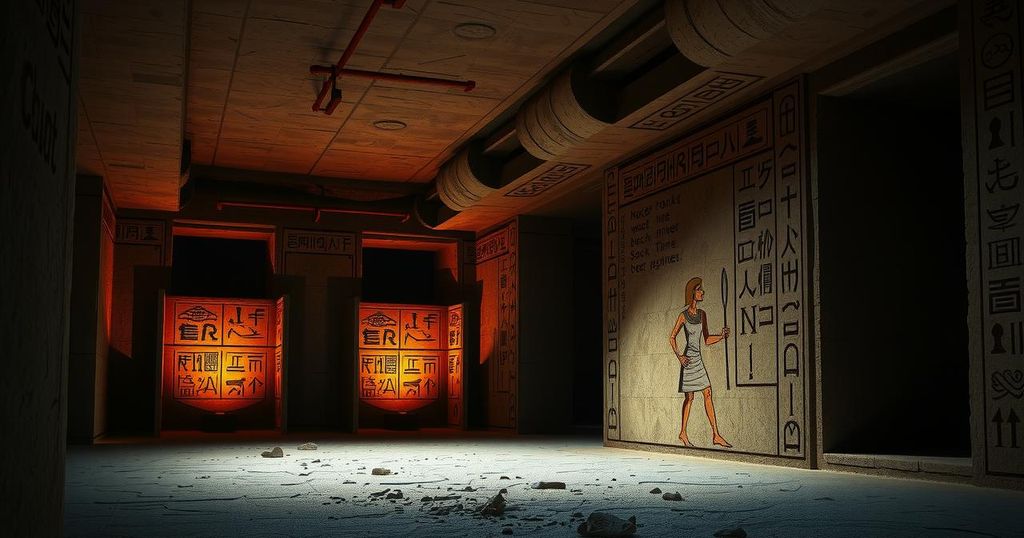Unveiling Secrets of the Giza Pyramids: Archaeological Discoveries Redefine History
Recent archaeological findings beneath the Giza Pyramids reveal mysterious underground structures potentially altering our historical understanding of these ancient monuments. Utilizing advanced technology, researchers have uncovered cylindrical formations, L-shaped structures, and skeletal remains that challenge traditional narratives. These discoveries may indicate purposes for the pyramids beyond tombs, suggesting a complex interplay of energy and construction techniques.
The Giza Pyramids, iconic symbols of ancient Egyptian civilization, may harbor secrets that could dramatically alter historical perspectives. Recent archaeological investigations have revealed mysterious underground formations beneath the pyramids, suggesting they may serve purposes beyond mere burial sites. These findings incorporate sophisticated technology and raise intriguing theories about the true nature of these ancient structures.
Recent studies led by Corrado Malanga from the University of Pisa and Filippo Biondi from the University of Strathclyde employed Synthetic Aperture Radar (SAR) to uncover enormous vertical cylindrical structures situated 648 meters beneath the Giza Plateau. Their 2022 research, published on arXiv, initially identified hidden chambers within the Great Pyramid. A March 15 press release elaborated on their discoveries beneath the Khafre Pyramid, revealing five identical structures arranged near the base, complete with five levels and sloped roofs, as well as eight hollow spiraling wells extending 648 meters. This expansive underground network, measuring two kilometers in length, exists beneath all three pyramids, hinting at a potential purpose not yet understood.
In addition to the cylindrical structures, the 2021-2023 Giza survey utilized ground-penetrating radar, uncovering an L-shaped formation 6.5 feet deep and another anomaly that may indicate an underground chamber lying 10 to 33 feet below. Motoyuki Sato of Tohoku University emphasized that this L-shape is unnatural in geological formations. Moreover, the 2023 Scan Pyramids initiative located a 30-foot corridor, further expanding the mystery surrounding the site.
Further complicating the narrative are skeletal remains discovered in March 2025, believed to be from Nubian origins, dating back to 3000 BCE, which predates the construction of the pyramids. Osteologist Dr. Sarah Field remarked that these findings disrupt the long-held belief that a homogenous local workforce constructed the pyramids. Traditional Egyptology suggests that the pyramids were built around 2500 BCE as tombs for pharaohs, utilizing ramps. However, the mathematics involved—incorporating Pi, the golden ratio, and even the speed of light—combined with recent findings, has sparked imaginative theories about their original purpose.
Though speculative, figures such as Nikola Tesla believed the pyramids harnessed Earth’s energy, while Christopher Dunn proposed the Great Pyramid functioned as an energy conversion power plant. Joseph Farrell posited it could have been utilized as an ancient weapon employing physics. Speculations suggest that these cylindrical wells might conduct energy or sound, with the associated cubes acting as generators. As reported by Greg Reese on Substack, the investigative team aims to excavate these sites further, although securing permits remains problematic. Given the drying of a Nile branch previously used for stone transportation, the tale of the pyramids increasingly resembles an epic narrative awaiting revelation.
In conclusion, the ongoing archaeological discoveries beneath the Giza Pyramids present new evidence that could reshape our understanding of ancient Egyptian civilization. The existence of previously unidentified underground structures, an uncommon skeletal narrative, and the implications of advanced mathematical principles all challenge traditional Egyptological perspectives. As research progresses and further excavations occur, the story of these monumental structures may evolve beyond their historical classification as mere tombs.
Original Source: www.marca.com




Post Comment